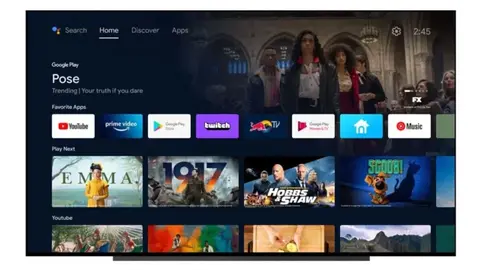In 2021, Google set the tech world buzzing when it unveiled its grand redesign plan for Android TV, drawing inspiration from its successful Google TV. Finally, after a prolonged wait, this ambitious transformation is beginning to roll out widely to users.
This Android TV overhaul, initially promised to arrive a few months later, has taken a whopping 31 months to materialize. Google, known for its knack for throwing curveballs, has left many wondering what to expect from this upgrade to the TV operating system.
Android TV vs. Google TV: A Tale of Two Interfaces Google’s television operating system comes in two distinct flavors: Android TV and Google TV. Beneath the surface, they share the same core, but it’s the external veneer that sets them apart. Google TV flaunts a sleeker, more content-centric interface, steering clear of the app-centric focus of its Android TV sibling (unless you opt for the application-only mode, of course).
Google’s Android TV Redesign: A Long-Awaited Transformation
Ever since its inception, Google has placed the spotlight squarely on Google TV, sidelining the basic Android TV iteration, except for the occasional release tied to a new Android version. However, Google has slowly been bridging the gap between the two, with the 2021 redesign being a significant step in that direction.
Unlocking the new TV Redesign The redesign in question boasts several key elements, including revamped top tabs and a new homepage that emphasizes content, akin to the Google TV experience. Yet, the rollout hasn’t been entirely uniform. User profiles, for instance, remain accessible only to select Android TV users.
Fast forward two years from the initial announcement, and the redesign is finally finding its way to all users, greeting them with a notification upon powering up their TVs. However, not all users are created equal in this rollout. Some regions are graced with the Discover tab, while others aren’t. And some enjoy a prominent content banner on their homepage, while others miss out.
Google’s Commitment to Change Back when Google first revealed its redesign aspirations, it also hinted at porting some Google TV features to Android TV. As the transition inches closer to completion and user profiles become universal, it’s plausible that Google may bid adieu to the basic Android TV iteration. In essence, the future of the OS may lie solely with Google TV. It’s where all the latest updates and features will converge.
Key features of the Android TV redesign:
- New, more modern look and feel
- Focus on content discovery
- Personalized recommendations
- Customizable home screen
- User profiles
- Support for live TV
The benefits of the Android TV redesign:
- It makes it easier to find content. The new home screen features a large carousel of recommended content, so you can easily find something to watch.
- It makes it easier to personalize your experience. You can create custom rows for your favorite apps and channels. َAnd you can also set up user profiles so that everyone in your household has their own personalized experience.
- It makes it easier to watch live TV. If you have a subscription to a live TV streaming service, you can now watch it directly on your device.
Overall, Google‘s Android TV redesign journey, initiated in 2021, has been a slow and unpredictable ride. However, as the transformation gradually becomes accessible to a wider audience, users can anticipate a more modernized and content-focused TV experience. The question that looms is whether this evolution will eventually spell the end for the traditional Android TV. Leaving Google TV as the sole torchbearer of the company’s television ambitions. Only time will tell how this tech saga unfolds.
